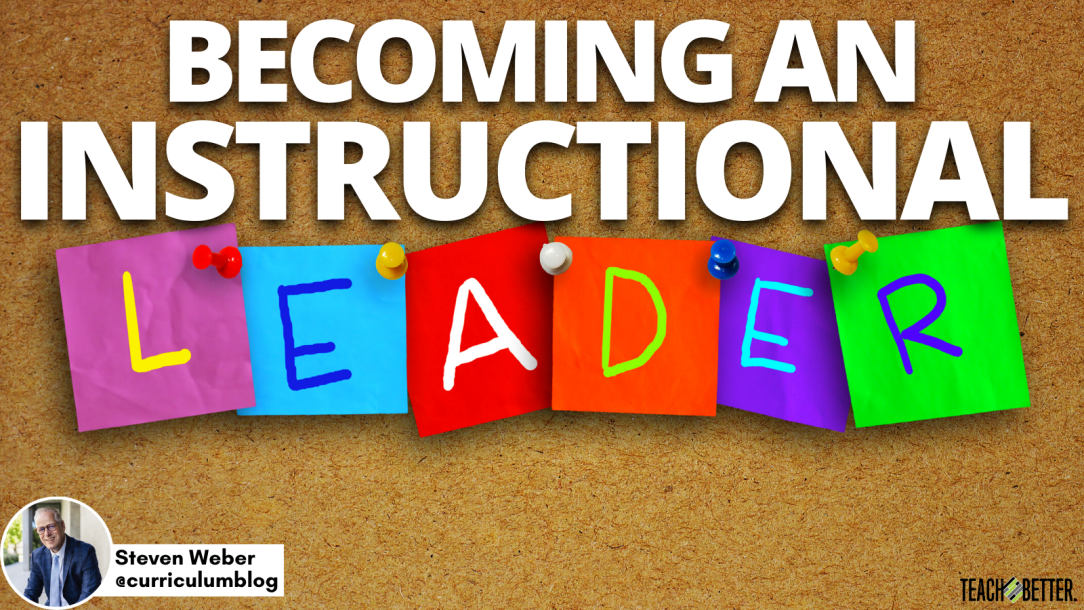TL;DR:
- Instructional leaders don’t have all the answers, especially at the beginning.
- It is important to tap into tools and resources to be an effective instructional leader.
How does an educator become an instructional leader? “An instructional leadership mindset includes an intense moral purpose focused on promoting deep student learning, professional inquiry, trusting relationships and seeking evidence in action” (Timperley, 2011). Instructional leadership is a role embraced by many different educators. Teachers, assistant principals, principals, curriculum directors, librarians, counselors, curriculum directors, assistant superintendents, and superintendents can each become instructional leaders.
Leading With Questions
When a teacher becomes an assistant principal or a school leader becomes a district leader, they can become overwhelmed by what they don’t know. A former math teacher may provide supervision and coaching to the science department. A new assistant superintendent may have experience with K-6 schools, but limited experience working in secondary schools. No one expects an instructional leader to have all the answers. The best instructional leaders lead with questions. Questions can provide a launchpad for curriculum design and professional dialogue.
No one expects an instructional leader to have all the answers. The best instructional leaders lead with questions. Click To TweetQuestions for Instructional Leaders
- Where are we now? Where are we going? How will we get there?
- Do we have a guaranteed and viable curriculum?
- Where is the curriculum housed, and do teachers use the curriculum to make instructional decisions?
- What barriers do students face as a result of our existing curriculum, learning targets, and materials?
- What barriers do teachers currently have?
- Do teachers feel like the curriculum is aligned (horizontally and vertically)?
- Have teachers or district teams created common formative assessments?
- Is the curriculum rigorous and relevant?
- What is the role of formative assessment in measuring the effectiveness of the written, taught, and understood curricula?
- What are the ‘enduring understandings’ that students should have as a result of this grade level or course?
- Based on observations in classrooms, does it appear that we have a ‘culture of learning’ or a ‘culture of compliance?’
- Does our school system have a process for curriculum design?
- What processes are in place when teachers and administrators identify gaps in the curriculum?
- Which students need additional academic support?
- What goals are we aiming for as we implement the curriculum?
Instructional Leaders are Facilitators
Instructional leaders do not need all of the answers. But they should provide teachers, staff, and administrators the opportunity to express their thoughts related to teaching and learning. “The facilitator’s role is to heighten the opportunity for increased dialogue, draw out ideas, help the group through conflict, provide solid processes to reach consensus and document the results…As groups become better and better at thinking together, the processes experienced become a recipe for future collaboration” (Bain, 2021). There are multiple ways to provide facilitative leadership.
5 Benefits of Facilitative Leadership Tools
- Allows participants to see and hear multiple perspectives
- Empowers critical thinking and problem-solving
- Promotes brainstorming
- Provides a safe method to discuss complex issues
- Places participants in the driver’s seat vs. the passenger seat
Facilitative Leadership Tools for Instructional Leaders
1. Force Field Analysis
2. Five Whys
3. SWOT Analysis
4. Dot Voting
5. Scenario Planning
6. Gallery Walk
Instructional Leaders Embrace Intentional Leadership
Without understanding the purpose of a meeting, it is easy to fall into the trap of planning without implementing and collaborating. According to Schmoker (2004), “Mere collegiality won’t cut it. Even discussions about curricular issues or popular strategies can feel good but go nowhere. The right image to embrace is a group of teachers who meet regularly to share, refine and assess the impact of lessons and strategies continuously to help increasing numbers of students learn at higher levels.” Instructional leaders are committed to supporting the work of a learning organization.
Instructional Leaders Focus on “Tunneling”
“Tunneling refers to a lack of bandwidth to solve problems. In a tunnel, you try to make your way forward. If you hit a problem, you just want to work around it and get it behind you so you can keep moving…You just keep tunneling” (Heath, 2020). New instructional leaders often struggle to focus on a few priorities. They may feel overwhelmed by initiative fatigue and state mandates.
Instructional Leaders Recognize and Embrace Collective Efficacy
A first-year curriculum director may discover that the district does not have a curriculum. A first-year department chair may become frustrated with the lack of time to develop common formative assessments. As you grow as an instructional leader, you will quickly embrace the many hats you wear while focusing on the needs of students and staff. Leading with questions, facilitative leadership, and tunneling will support instructional leaders at all levels in a school district. Rather than attempting to solve every problem, find the experts who work closest with students. Lean into the collective efficacy and experiences of teachers and administrators. Instructional leaders empower those around them to become successful.
[scroll down to keep reading]Additional Resources for Instructional Leaders
District Leadership: Teacher-Driven Curriculum Design (podcast, 2018)
How Does Your School Determine Priorities?
Leading With Questions: A Playbook For School Leaders
The 3 C’s of Curriculum Leadership
The Instructional Leader Manifesto (ASCD, 2019)
References
Bain, M. (2021). The power of facilitation for critical thinking. Retrieved from https://facpower.org/2021/07/13/3-the-power-of-facilitation-for-critical-thinking/
Heath, D. (2020). Upstream: The quest to solve problems before they happen. Simon & Schuster.
Schmoker, M. (2004). Start here for improving teaching. The School Administrator 61(10), 48–49.
Timperley, H. (2011). Realizing the power of professional learning. Open University Press.
About Steven Weber
Dr. Steven Weber is a curriculum leader. He has served on multiple state and national boards. His areas of research include curriculum design, multiplying leaders, professional learning, and school leadership.




